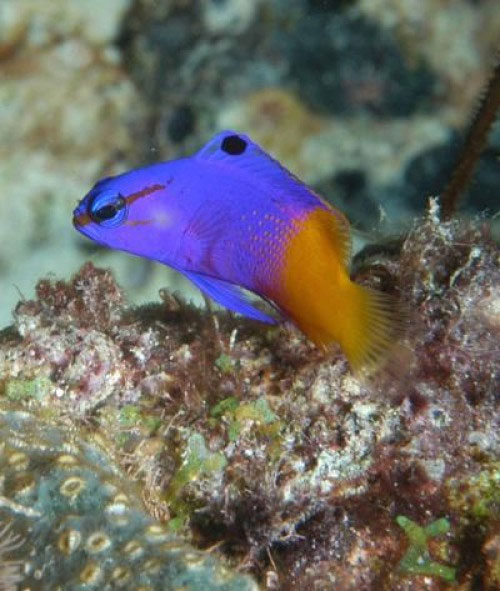Why lion fish are destructive compared to other predators
(New research on the carnivorous nature of red lionfish, an invasive Pacific creature that is destroying native fish populations in the Caribbean and the Atlantic Ocean Yang, it seems that the lion fish is not merely a carnivore but it is like a "destroyer" in a famous movie.
The result of that behavior called "alarming " was published by Kurt Ingeman, a researcher from Oregon State University, at the annual meeting of the American Ecological Society.
Most indigenous predatory fishes are attracted when the number of prey is large, when the attacks are the easiest and most energy-efficient to chase and eat other fish, this is the conclusion of An earlier study was carried out by Dr. Ecological researcher Michael Webster fish of Oregon State University. As the number of prey decreases, native predators often move to other areas, where hunting is easier.
This new study also concluded that lion fish, compared to other predatory fish, often appear in an area even when the number of prey in that area is declining , and in some cases they have Can eat the last fish that cause extinction.
They have strange characteristics to do that, and like a destroyer, they simply won't stop until the last prey is destroyed.
"Lion fish seems to be the last invader, " said Ingeman, a doctoral candidate at the Department of Synthetic Biology at Oregon State University's University of Science. 'Almost everything we know about this species is what makes them a more formidable predator. And now it is clear that they are still hunting successfully even if there are only a few prey . This behavior is unusual and alarming '.

The study was conducted on natural coral reefs spread in the Bahamas, to assess the mortality rate of the fairy basslet, a popular aquarium fish and a popular prey of lion fish.
The carnivorous ratio is compared between coral reefs with invasive lion fish and coral reefs with only native predators, and through a range of levels of fairy basslet fish populations.
Ingeman found that when prey is present in an area with low fish density, the death rate of lion fish is 4 times higher than that of other predatory fish such as medium sized grouper or fish. lime key. The researchers say this finding is important because the fairy basslet lives in small, vulnerable indigenous populations that lead to local strains.
It also shows that the mechanism of adjusting the number of individuals of a population can also be changed.
"Coral reef fish are often hidden in rock holes and openings for defense, and in large numbers, there will be a fight for shelter , " Ingeman said. 'Indigenous predators primarily take advantage of this situation by catching fish where the fish have no shelter. When the number of prey decreases, it takes a lot of energy to catch the prey, so predators often leave to other areas. '
Because this is what scientists call 'density-dependent dependence' , native fish populations tend to shrink when too large, grow when they are too small, and rarely completely wiped out.
However, lion fish have the advantages of an invasive species, it does not need to be moved to other places for easier hunting. Other fish may not recognize it as a carnivore, and therefore prey has a high mortality rate even when abundance is abundant. These fishes are also very effective hunters, they have poisonous spikes to protect themselves and can live deep in the ocean floor. They tolerate a wide range of different water environment conditions, reproduce quickly, eat a variety of fish and can eat many rare fish species.
Ingeman said it is unclear whether evolutionary pressure could help the Atlantic fish native to adapt to better resistance to lion fish.
Igeman said: 'There is a strong pressure on natural selection with the final results'. 'We know that fish can learn and change their behavior, sometimes only for a few generations. But we don't have any research to prove this is happening in the indigenous fish populations in the Atlantic. '
The invasion of lion fish in the Atlantic is thought to have started in the 1980s and now occupies a wider area than the United States.
The adviser of Ingeman, Mark Hixon, and other authors have shown that lion fish can wipe out more than 90% of many native fish species in some areas that have been badly damaged.
- Invention robot destroying lion fish
- The extremely poisonous lion fish is invading the Atlantic
- Close-up of the poisonous drama assassin causing extreme pain in the deep sea
- Terrifying assassin in the Caribbean Sea
- 10 most dangerous predators
- Hungry sharks tear the lion fish
- Lion fish threatens the Atlantic Ocean
- Attack on lions, wildebeest pay for their lives
- Large predators are disappearing
- Bagged lions once existed
- The first tiger lion gave birth in Russia
- Discovering fish is evolving to prepare water to live on shore
 Surprised: Fish that live in the dark ocean still see colors
Surprised: Fish that live in the dark ocean still see colors Japan suddenly caught the creature that caused the earthquake in the legend
Japan suddenly caught the creature that caused the earthquake in the legend A series of gray whale carcasses washed ashore on California's coast
A series of gray whale carcasses washed ashore on California's coast Compare the size of shark species in the world
Compare the size of shark species in the world